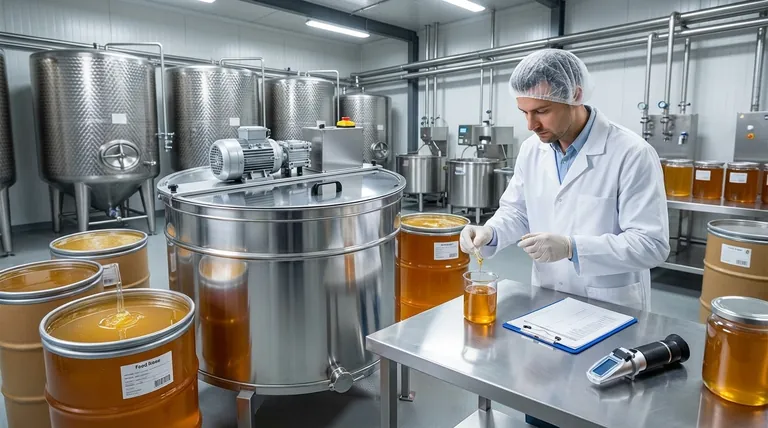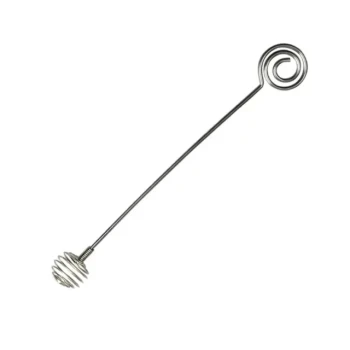When selecting a honey supplier for a processing line, you must evaluate them across four critical pillars: verifiable product quality, operational reliability, certified safety compliance, and transparent pricing. This decision is not merely a purchase but a strategic partnership that directly dictates the consistency, safety, and reputation of your final product.
The core challenge is not simply finding a source for honey, but establishing a reliable supply chain partner. Success depends on shifting your mindset from a simple transaction to a long-term collaboration built on transparency, quality, and mutual trust.

The Four Pillars of Supplier Vetting
A truly effective supplier evaluation goes beyond a simple price list. It requires a systematic assessment of their operations, quality control, and ability to function as a reliable partner in your production process.
Pillar 1: Verifiable Product Quality and Consistency
The characteristics of the raw honey are the foundation of your finished product.
Your supplier must provide detailed specifications for their honey, including moisture content, color, and floral source. This ensures the raw material meets your processing and labeling requirements from the start.
Crucially, you must assess batch-to-batch consistency. A reliable supplier can deliver honey with a predictable flavor profile and composition over time, which is essential for brand integrity.
Demand full traceability. The supplier should be able to track the honey back to its origin, providing transparency and validating claims such as "local" or "single-origin."
Pillar 2: Operational Reliability and Capacity
A high-quality sample is meaningless if the supplier cannot deliver at scale and on schedule.
Evaluate the supplier's production capacity to ensure they can consistently meet your volume demands without interruption, especially during periods of growth.
Analyze their logistics and distribution network. A supplier's location and shipping capabilities have a direct impact on freight costs, delivery times, and the potential for supply chain disruptions.
On-time delivery is non-negotiable. A supplier's track record for reliability is a key indicator of their professionalism and respect for your production schedule.
Pillar 3: Rigorous Safety and Compliance Standards
In food processing, compliance is not optional. A supplier's commitment to safety protects your business and your customers.
Look for recognized food safety certifications, such as SQF (Safe Quality Food), BRC (Brand Reputation Compliance), or organic certifications. These third-party audits validate their processes.
Inquire about their quality assurance protocols. This includes their own internal testing procedures for contaminants, adulteration, and product specifications.
Ensure they can provide all necessary documentation, such as a Certificate of Analysis (COA) with every shipment, to satisfy your own regulatory and quality control needs.
Pillar 4: Transparent Pricing and Total Cost
The price per pound is only one part of the financial equation.
You must understand the total cost of acquisition. This includes the base price plus any additional charges for shipping, palletizing, or other handling fees.
Clarify payment terms and potential hidden costs upfront. This prevents financial surprises and helps you accurately forecast your cost of goods sold.
While cost is important, it must be balanced with the other three pillars. A low price rarely compensates for poor quality or an unreliable supply.
Understanding the Trade-offs
Choosing a supplier always involves balancing competing priorities. Being aware of the common pitfalls can prevent costly mistakes.
The Danger of a Price-Only Decision
Selecting the cheapest supplier is one of the most common and damaging mistakes. This approach often leads to inconsistent quality, unreliable deliveries, and potential food safety risks that can jeopardize your brand's reputation.
Assuming a Single Supplier is Sufficient
Relying on a single source of honey creates significant business risk. A poor harvest, logistical failure, or business change on their end can halt your entire production line. It is wise to identify and vet both a primary and a secondary supplier.
Overlooking the Supplier's Reputation
Always check references and seek out client testimonials. A supplier's reputation within the industry is a powerful indicator of their business practices, product quality, and how they handle challenges when they inevitably arise.
Making the Right Choice for Your Operation
Your optimal supplier depends on your specific business goals. Use your priorities to guide your final decision.
- If your primary focus is a premium, artisanal product: Prioritize suppliers who offer exceptional quality, full traceability to a specific floral source, and a brand story that aligns with yours.
- If your primary focus is scaling a high-volume product: Emphasize suppliers with proven capacity, logistical efficiency, and competitive, transparent pricing to manage your margins effectively.
- If your primary focus is maximum food safety and compliance: Your decision should be weighted heavily toward suppliers with robust, third-party certifications and comprehensive documentation for every batch.
Ultimately, selecting the right honey supplier is a foundational decision that secures the quality and integrity of your entire processing operation.
Summary Table:
| Pillar | Key Considerations |
|---|---|
| Product Quality | Batch-to-batch consistency, moisture content, floral source, full traceability. |
| Operational Reliability | Production capacity, logistics network, on-time delivery track record. |
| Safety & Compliance | SQF/BRC certifications, internal QA protocols, Certificate of Analysis (COA). |
| Pricing & Cost | Total cost of acquisition (base price + fees), transparent payment terms. |
Ready to build a reliable supply chain for your honey processing line?
HONESTBEE is your trusted partner for commercial honey production. We supply high-quality beekeeping supplies and equipment to commercial apiaries and distributors through wholesale-focused operations. By partnering with us, you gain access to the reliable resources needed to ensure product consistency and operational efficiency.
Contact HONESTBEE today to discuss how our wholesale solutions can support your success.
Visual Guide

Related Products
- 24 Frame Honey Extractor Commercial Radial Honey Frame Extraction Machine
- 8-Frame Electric Self-Reversing Honey Extractor Spinner for Commercial Honey Extraction Equipment
- HONESTBEE 72 Frame Industrial Electric Honey Extractor for Beekeeping
- electric honey extractor honey centrifuge 3 frame honey extractor stainless steel honey frame extractor
- Easy Use Manual Stainless Steel Honey Press for Honey Comb
People Also Ask
- What is a radial extractor and why is it preferred by some beekeepers? Maximize Your Honey Harvesting Efficiency
- Can honey extractors accommodate different frame sizes? A Guide to Choosing the Right Extractor
- What are the advantages of a stainless steel honey extractor? Ensure Honey Purity & Long-Term Value
- What are the recommended extractor sizes based on the number of hives? A Guide for Every Apiary Scale
- How should the extractor be cleaned after use? Protect Your Honey & Equipment Investment



















